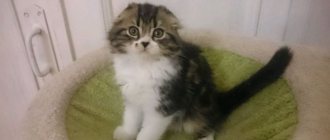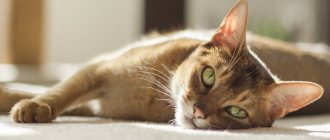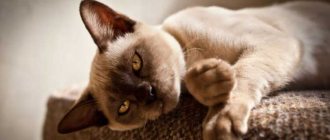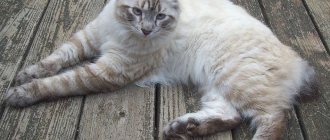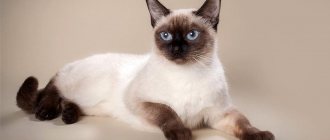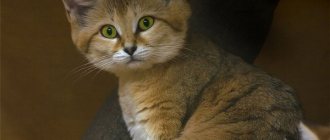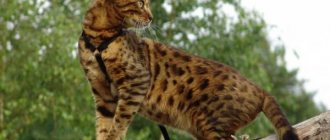In cat colors, white is presented in different variations from minimal, in the form of single hairs, “slippers”, “tie” to a completely white animal. Externally, only the area of its distribution is assessed.
The presence of white depends on the influence of three different genes, which do not necessarily have to be present simultaneously in the animal. At its core, it is not a color; it is more correct to talk about its absence or camouflage. In other words, white does not allow the main color to appear or the animal completely lacks pigment.
For a correct understanding, you need to know about the fundamental genetic differences between white cats. Completely white cats have a dominant white gene in their genotype, which prevents the main color from appearing. If an animal has white from single spots to almost complete color with colored areas, then this is due to the white spotting gene. Albinism, or the complete absence of pigment, is influenced by a gene that distributes color throughout the animal's body. Three different genes are located in different loci and have their own characteristics of external manifestation.
The dominant white and white spotting gene are located in a different locus in relation to the genes for black or red colors, therefore they are epistatic
.
They manifest themselves according to the principle of epistasis
, when a dominant or recessive gene affects another dominant one located in a different locus and completely or partially overlaps it. The albinism gene is recessive and manifests itself only in the homozygous recessive genotype.
Why is a cat born white?
Three genes are responsible for the purity of the snow cat color - albinism “c”, white color W and piebaldity S.
- From a scientific point of view, an albino cat is completely colorless, since its genetic makeup contains the “ca” gene, which characterizes the complete absence of pigment in color. A pure albino with a red iris is very rare. Albino with blue eyes, not very bright, is more common in the cat world. The “c” gene is responsible for the coloring of such an animal.
- If a female, a carrier of the dominant white W gene, is crossed with a representative of a different color, then the kittens in the litter will repeat the color of the mother. When two W carriers are combined, the offspring can be of any color. These animals have bright blue or blue eyes, but they are also found with topaz or green irises.
- The S piebald gene is characterized by solid white spots in the color of the animal. Visually, the cat is perceived as a clean, even, snowy shade. If these spots do not merge, other colors are present in the color. Eye color blue, yellow, green.
Norwegian Forest Cats are white
Ocicat
An elegant, slender but muscular cat with a well-proportioned head and large ears. Ocicats are descendants of Siamese and Abyssinians, therefore they are sociable, playful and inquisitive. Nobody planned to breed them: the first Ocicat appeared in a Siamese cattery and became a considerable surprise for the breeder.
The fact is that she wanted to diversify the colors allowed by the standards of the Siamese breed (in the 60s of the last century such experiments were more tolerant). And she attracted Abyssinian cats for mating. And one day she received a magnificent spotted kitten, which did not at all live up to her expectations. However, the idea of creating a new breed came to her only after she told a famous geneticist about the unusual kitten.
Color and deafness
Many white cats are deaf due to inner ear degeneration. Geneticists studying these animals have determined that their deafness depends on eye color:
- 17-22% with eyes of any color except blue;
- about 40% are heterochromic (i.e. with different colors);
- 65-85% with blue eyes.
In cats with different eyes, hearing loss is usually observed on the side of the blue eye.
Kao-mani with blue eyes
The cause of deafness is in the dominant W gene. After much research, scientists have determined that it is pleiotropic - it is responsible for a number of traits in the genotype - not only for coat color, but also for deafness and blue-eyedness. By the way, you can also read about blue-eyed cats and breeds on our portal.
The dominant W allele disrupts the migration of melanoblasts—pigment producers and transporters—and also affects the activity of other cells in the area of the neural tube of the embryo
Deaf cats are excluded from the breeding program. And as a pet, they can live as absolutely full-fledged individuals; the lack of hearing is compensated by other senses. True, such animals will not survive on the street.
Bengal
Of course, this is the first of the spotted cat breeds, although the standards allow merle colors (by the way, very striking ones). But the Bengal spots, called rosettes, are very beautiful - after all, they are surrounded by a spectacular dark border.
And the Bengals themselves are good: athletic, muscular, with a small head, neat ears with rounded tips. Another interesting feature of the breed is the specific shine of the coat, the so-called glitter effect. Some hairs are transparent and shine in the sun (or light). It feels like the fur is shining.
This is the oldest and most famous breed, obtained through interspecific crossing (of a domestic cat and an Asian leopard cat). Of course, it is much more difficult to breed such a breed: it took its creator, J. Mill, 30 years.
White cats
Many cat breeds are white. But there are also those for whom this color is a distinctive feature.
Khao-mani
This breed came to the world from Thailand. Translated from Thai as “white gem”. In English-speaking countries it is often called "Diamond Eye". Snowy fur and heterochromia are the distinguishing features of these cats.
This ancient variety is mentioned in the manuscript "Book of Poems about Cats." For many centuries, she could only be a pet of the royal house.
Kittens are often born with a dark spot on their head, which usually disappears with age. But sometimes there are individuals that are not pure white, spotted. Eyes can be of different colors - amber, green, blue. Heterochromia is rare. Approximately half of animals suffer from hearing loss in one or both ears.
Egyptian Mau
This is a slender, well-built cat of medium size. Her features are a fold of skin on her stomach, thanks to which the Egyptian is capable of impressive jumps, and a unique eye color of an interesting shade of green, which is compared to the color of an unripe gooseberry. Her character is sociable and friendly.
Egyptian Mau are descendants of the very cats that were so revered in Ancient Egypt. The history of the breed (in the modern sense) began more than a hundred years ago, but almost ended during the Second World War. The restoration of the breed was undertaken by the Russian princess N. Trubetskaya. Of course, it is difficult to say whether the ancestors of modern Egyptian women were descendants of those same ancient Egyptian cats, but it is reliably known that the princess imported animals for breeding work from Cairo.
What happens if you have a white cat at home?
There are many superstitions about white cats. People believe that they absorb negative energy, protect against the evil eye, and protect from illness and trouble.
- If a white cat crosses the road. It is believed that if a black cat crosses a person’s path, then misfortune awaits the latter. This belief exists in many countries. A white cat in this case, on the contrary, promises good luck. In Ireland, it is believed that you need to say hello to her, and if Snow White answers, then this is a sign of an imminent win or major success.
- White cat in the house. In many countries, it is believed that with a white cat good luck in business and prosperity comes to the house. Especially if it is a pet with one blue eye. If such a female gave birth to snow-white kittens, then well-being is guaranteed forever. In England, on the contrary, if a strange white cat enters the house, financial losses lie ahead. As soon as he comes out, he will take with him luck and money.
- How to behave around white cats. The British never offend their snow-white pets - otherwise you will bring misfortune on yourself. You need to pet the cat, treat it with a treat, and then the day will turn out great.
- See it in a dream. A dream involving a snow-white beauty promises a woman an early pregnancy. Another superstition is that she needs to pay attention to her children.
- White wool. Touching the long white wool in Albania means that you will soon get better, gain weight, and for a woman, you will soon become pregnant.
- White cat and marriage. If a person finds owners for seven white kittens, then his personal life will soon develop. In this case, women must accommodate females, and men - males. Newlyweds who meet a white cat along the way need not worry; their family will be strong and happy.
- Bad luck. Interestingly, in the countries of the Middle East everything is exactly the opposite. If a white cat crosses the road, especially at night, there will be trouble.
- Child and snow-white cat. North American Indian beliefs prohibit keeping a white cat in the house if there is a baby in the family. And in the Mediterranean countries, an animal of this color in the house is the key to a future happy life for the baby.
Serengeti
Slender, very graceful, quite large, long-legged cat, with a small head on a long neck and very large ears located high. The Serengeti has a friendly and sociable character; such a pet will find the strength to play with all family members.
This will seem strange, but the goal of the breeding work of Serengeti breeders is the same as that of Savannah breeders - maximum resemblance to the appearance of the serval. Only these robots are built completely differently: without involving wild animals, but by mating Bengals and Orientals. Today the breed has not received full recognition and has a preliminary status - the Serengeti can participate in exhibitions, but does not receive titles.
Conditions of detention
Siamese cats thrive both in the city and outside in the countryside. Without special need, these cats do not have the habit of running around the room, so they do not need a lot of space, and they will be quite happy living in a small apartment, where they need to create conditions for entertainment in the form of “climbing areas” specially designed for cats.
But since Siamese cats are considered descendants of hunting animals, the opportunity to hunt rodents on a private property will bring them great pleasure. Here they can play with family members and hunt small rodents and reptiles.
Did you know? Siamese cats can live up to 30 years, like the Siamese cat Scooter from the USA, born in 1986 and died in 2016. Although there is a known case where a Siamese cat died at the age of 38.
Main characteristics
Thanks to the unique coloring, the Siamese cannot be confused with other individuals. Pets have deep blue eyes and a rather intelligent and expressive look.
The weight of an adult cat is usually 4-5 kilograms. Animals that have undergone sterilization or castration can weigh 7-8 kilograms.
The height of cats is small and is 23-25 centimeters at the withers. The length of the body does not exceed 60 centimeters.
The color of these animals is unique. The main part of their body is light, and the tail, paws and muzzle are dark.
If you provide your cat with proper care and proper nutrition, its life expectancy can be 25 years.
The character of the Siamese cat is independent and stubborn. Cats are friendly towards both adults and children. They become very attached to their owner.
Siamese cats are very sensitive to the mood of their owner and can show jealousy towards him.
Despite the craving for loneliness, Siamese love cheerful company and are able to attract attention
Speaking about the character of the animal, it is worth mentioning its touchiness. Getting forgiveness from a punished or offended cat is not so easy.
Varieties of Siamese also include the Oriental, Mekong Bobtail and Thai Siamese.
Caring for a Siamese kitten
It is simple due to the short hair and the love of cleanliness of animals of this breed; in addition to combing, take care of the eyes and ears by wiping them daily with a cotton pad soaked in Vaseline oil (for ear care) or in water (for the eyes).
The love of drinking (as opposed to swimming and water procedures) is in the blood of Siamese representatives; use a bowl with a wide bottom or a special automatic fountain drinker. Leave the food only in the amount that will be enough for one meal, wash the empty bowl with hot water before the next filling, and discuss regular food with your veterinarian. The tray also needs to be cleaned after the “hike”.
Siamese kittens are very popular and therefore widespread. If you are interested in the price, then Avito offers to buy kittens almost for nothing or free of charge “in good hands.” It is better to purchase a kitten with a pedigree from a nursery. Here their cost (based on data from Moscow nurseries) is from 15 to 25 thousand rubles, in the regions it is cheaper - 7-15 thousand.
Pixiebob
This is a powerful, fairly large, muscular cat, with deep-set eyes - which gives the look a “wild” expression, tufts at the tips of the ears, a powerful chin and a short tail. In a word, she looks like the North American red lynx, the appearance that breeders strive for. Interestingly, breed standards allow for the presence of extra toes, which is a disqualifying feature for absolutely all other breeds.
Attempts to create a breed similar to the lynx were made more than once, but until the mid-80s of the last century they were unsuccessful. Until K. Brewer, the creator of the breed, acquired an unusual kitten with a short tail. She developed a breeding program that was quickly crowned with success: pixie beans were recognized in the mid-90s. The breed got its name in honor of one of the first representatives of the breed - Pixie.
Perhaps the spotted color does not make such a strong impression as the rarer color-point (the so-called Siamese), white, blue or lilac. But it was the spots that helped cats survive for thousands of years - after all, this pattern perfectly camouflages the animal, allowing it to sneak up on prey and escape from enemies.
A gray cat, especially a pure color, looks like a sophisticated and elegant animal. These airy, mystical animals seem to be shrouded in a misty haze of fur. The gray kitten seems to fly away like a feather if you blow on it. Not surprisingly, blue is one of the most popular colors. There are also many connoisseurs of marbled or spotted tabby in black and ash tones. Moreover, gray fur color is included in the standards of many breeds.
How much does a Siamese kitten cost?
The average price for a Siamese kitten is 8,000 – 35,000 rubles (5,000 – 10,000 UAH).
What does the price depend on?
Price formation is influenced by:
- kitten class;
- floor;
- colors;
- age;
- prestige of the nursery;
- parents' titles;
- sale with or without breeding rights;
- pedigree.
The biggest influence on the cost is belonging to a certain class:
- SHOW (show) – kittens are sold with the right to breed and are allowed to participate in exhibitions and competitions. Price: from 25,000 to 45,000 rubles;
- BREED - healthy kittens without genetic pathologies and good characteristics, have minor deviations from the standard, can be exhibited and allowed for breeding. They cost from 10,000 to 15,000 rubles.
- PET (pet) - pets without the right to breed, are not allowed to exhibitions. Price: from 3,000 to 10,000 rubles.


